Module 2 Unit 4 Inventions 单元教学设计
文档属性
| 名称 | Module 2 Unit 4 Inventions 单元教学设计 | 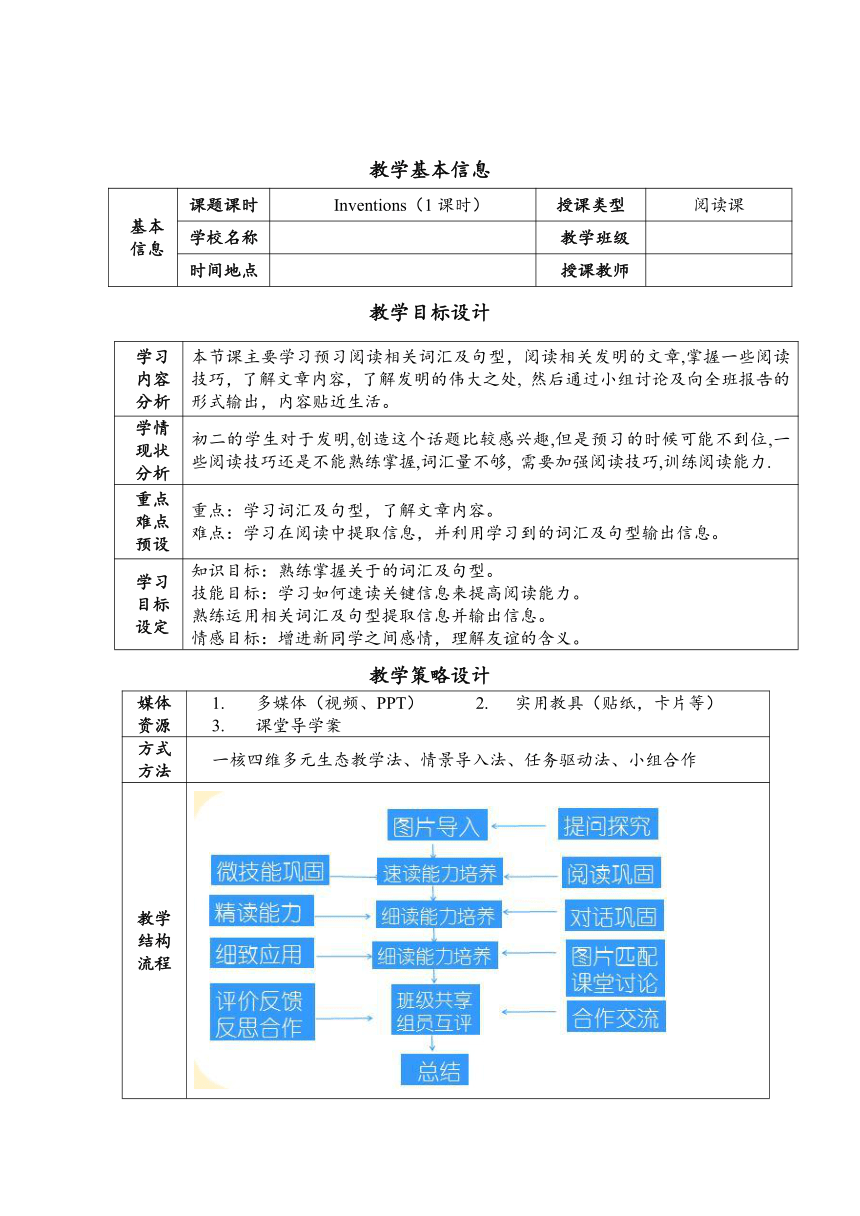 | |
| 格式 | zip | ||
| 文件大小 | 1.2MB | ||
| 资源类型 | 教案 | ||
| 版本资源 | 牛津深圳版 | ||
| 科目 | 英语 | ||
| 更新时间 | 2020-05-13 13:52:15 | ||
图片预览

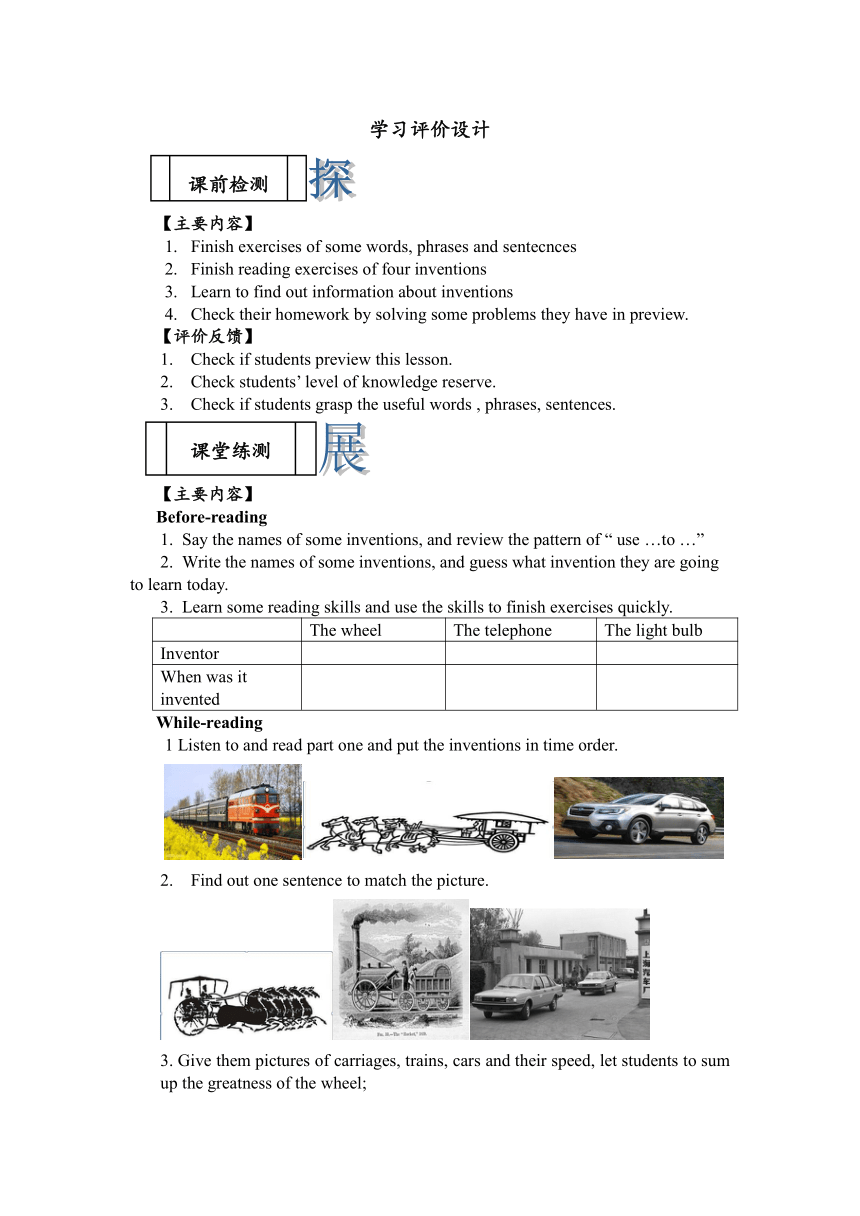
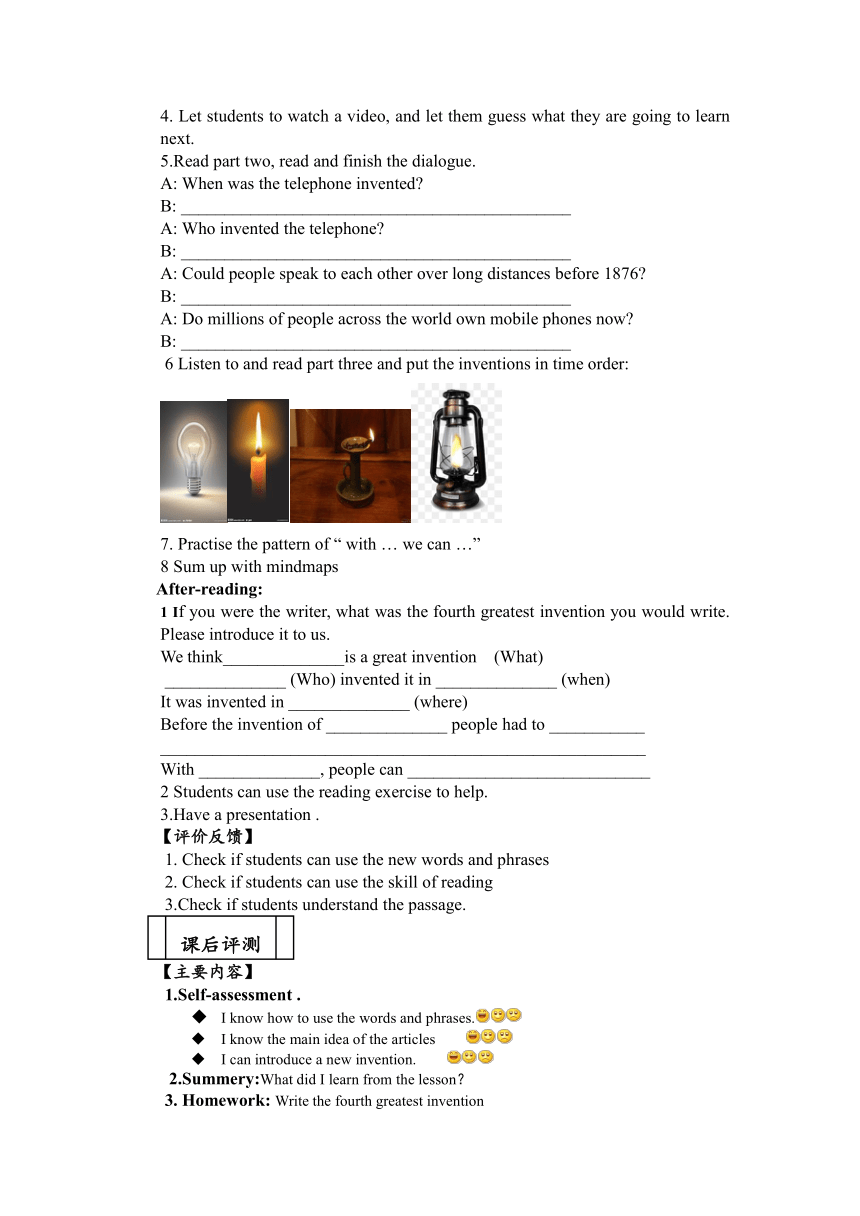
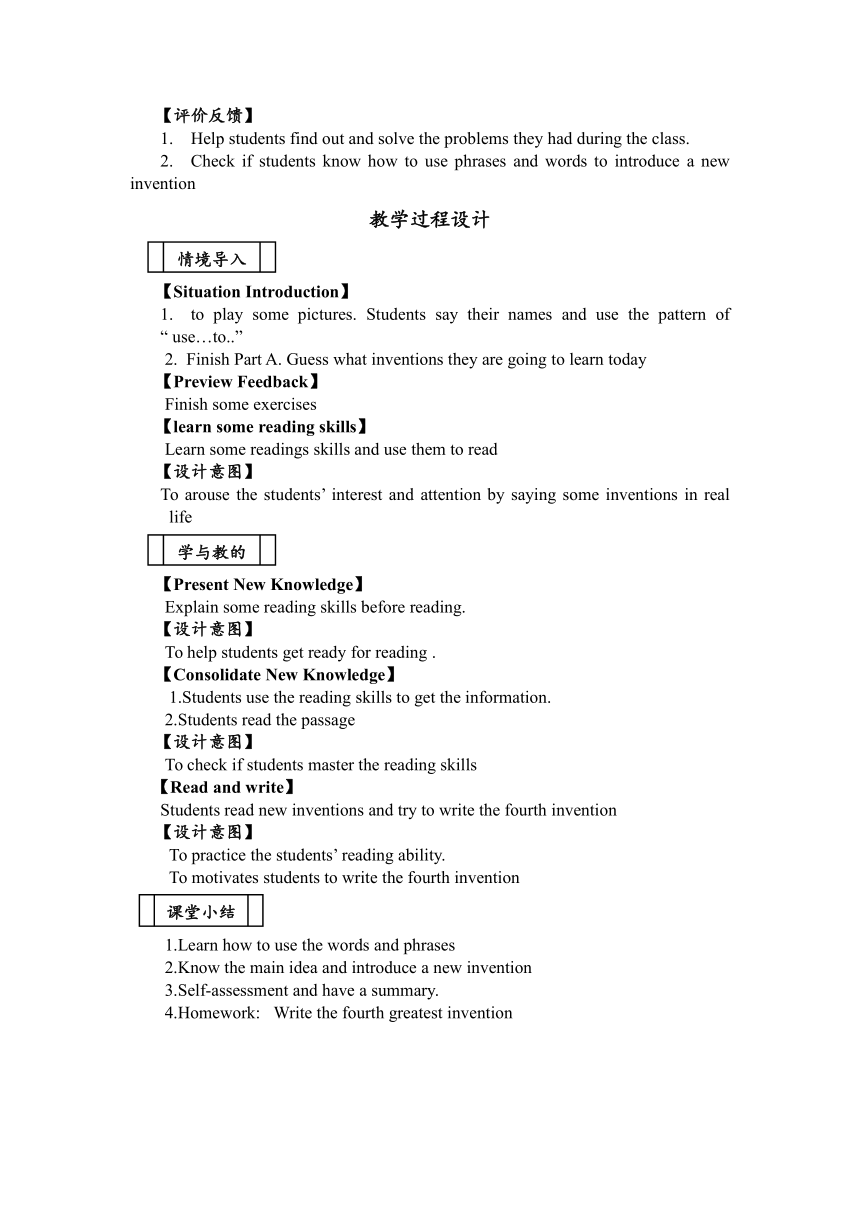
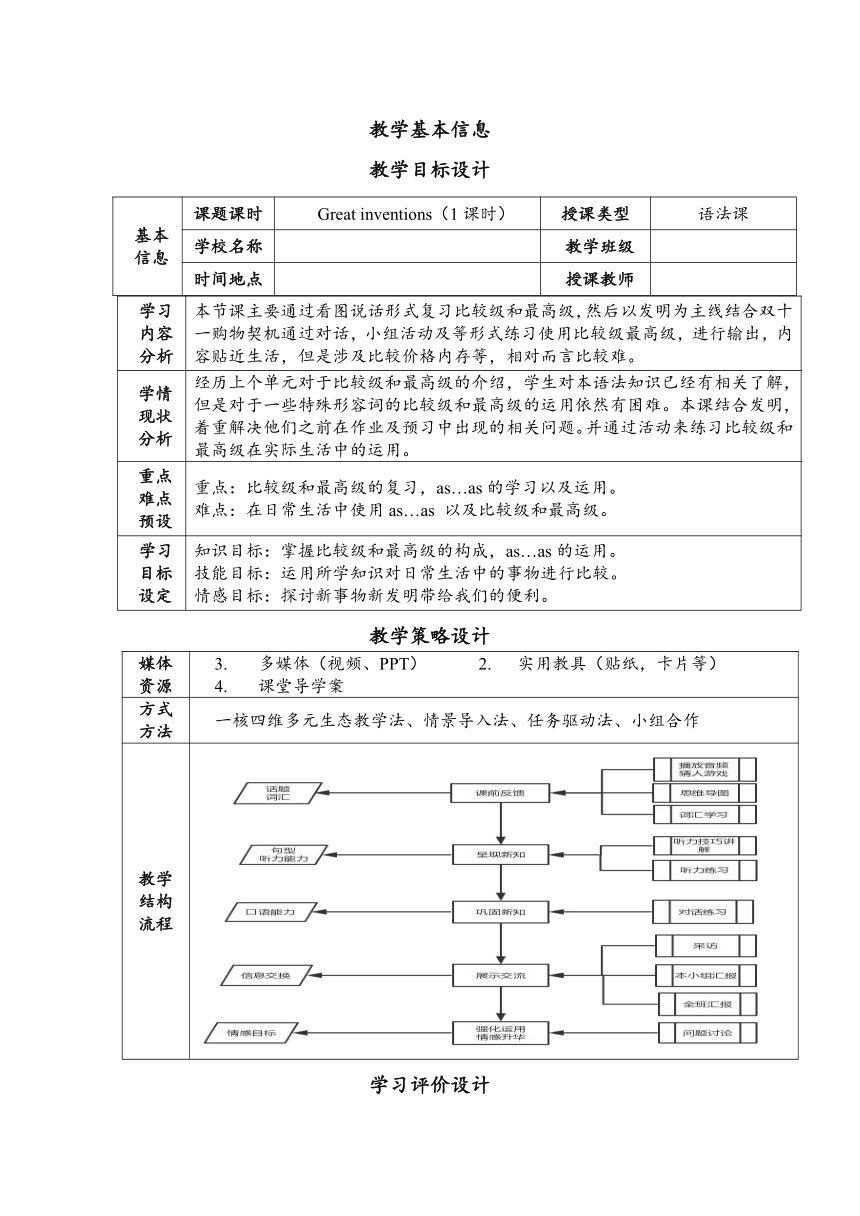
文档简介
基本 信息 课题课时 Inventions(1课时) 授课类型 阅读课
学校名称 教学班级
时间地点 授课教师
教学基本信息
学习 内容 分析 本节课主要学习预习阅读相关词汇及句型,阅读相关发明的文章,掌握一些阅读技巧,了解文章内容,了解发明的伟大之处, 然后通过小组讨论及向全班报告的形式输出,内容贴近生活。
学情 现状 分析 初二的学生对于发明,创造这个话题比较感兴趣,但是预习的时候可能不到位,一些阅读技巧还是不能熟练掌握,词汇量不够, 需要加强阅读技巧,训练阅读能力.
重点 难点 预设 重点:学习词汇及句型,了解文章内容。 难点:学习在阅读中提取信息,并利用学习到的词汇及句型输出信息。
学习 目标 设定 知识目标:熟练掌握关于的词汇及句型。 技能目标:学习如何速读关键信息来提高阅读能力。 熟练运用相关词汇及句型提取信息并输出信息。 情感目标:增进新同学之间感情,理解友谊的含义。
教学目标设计
教学策略设计
媒体 资源 多媒体(视频、PPT) 2. 实用教具(贴纸,卡片等) 课堂导学案
方式 方法 一核四维多元生态教学法、情景导入法、任务驱动法、小组合作
教学 结构 流程
学习评价设计
(
课前检测
)
【主要内容】
Finish exercises of some words, phrases and sentecnces
Finish reading exercises of four inventions
Learn to find out information about inventions
Check their homework by solving some problems they have in preview.
【评价反馈】
Check if students preview this lesson.
Check students’ level of knowledge reserve.
Check if students grasp the useful words , phrases, sentences.
(
课堂练测
)
【主要内容】
Before-reading
Say the names of some inventions, and review the pattern of “ use …to …”
Write the names of some inventions, and guess what invention they are going to learn today.
Learn some reading skills and use the skills to finish exercises quickly.
The wheel The telephone The light bulb
Inventor
When was it invented
While-reading
1 Listen to and read part one and put the inventions in time order.
Find out one sentence to match the picture.
3. Give them pictures of carriages, trains, cars and their speed, let students to sum up the greatness of the wheel;
4. Let students to watch a video, and let them guess what they are going to learn next.
5.Read part two, read and finish the dialogue.
A: When was the telephone invented?
B: _____________________________________________
A: Who invented the telephone?
B: _____________________________________________
A: Could people speak to each other over long distances before 1876?
B: _____________________________________________
A: Do millions of people across the world own mobile phones now?
B: _____________________________________________
6 Listen to and read part three and put the inventions in time order:
7. Practise the pattern of “ with … we can …”
8 Sum up with mindmaps
After-reading:
1 If you were the writer, what was the fourth greatest invention you would write. Please introduce it to us.
We think______________is a great invention (What)
______________ (Who) invented it in ______________ (when)
It was invented in ______________ (where)
Before the invention of ______________ people had to ___________
________________________________________________________
With ______________, people can ____________________________
2 Students can use the reading exercise to help.
3.Have a presentation .
【评价反馈】
1. Check if students can use the new words and phrases
2. Check if students can use the skill of reading
3.Check if students understand the passage.
(
课后评测
)
【主要内容】
1.Self-assessment .
I know how to use the words and phrases.
I know the main idea of the articles
I can introduce a new invention.
2.Summery:What did I learn from the lesson?
3. Homework: Write the fourth greatest invention
【评价反馈】
Help students find out and solve the problems they had during the class.
Check if students know how to use phrases and words to introduce a new invention
教学过程设计
(
情境导入
)
【Situation Introduction】
to play some pictures. Students say their names and use the pattern of “ use…to..”
Finish Part A. Guess what inventions they are going to learn today
【Preview Feedback】
Finish some exercises
【learn some reading skills】
Learn some readings skills and use them to read
【设计意图】
To arouse the students’ interest and attention by saying some inventions in real life
(
学与教的活动
)
【Present New Knowledge】
Explain some reading skills before reading.
【设计意图】
To help students get ready for reading .
【Consolidate New Knowledge】
1.Students use the reading skills to get the information.
2.Students read the passage
【设计意图】
To check if students master the reading skills
【Read and write】
Students read new inventions and try to write the fourth invention
【设计意图】
To practice the students’ reading ability.
To motivates students to write the fourth invention
(
课堂小结
)
1.Learn how to use the words and phrases
2.Know the main idea and introduce a new invention
3.Self-assessment and have a summary.
4.Homework: Write the fourth greatest invention
教学基本信息
基本 信息 课题课时 Great inventions(1课时) 授课类型 语法课
学校名称 教学班级
时间地点 授课教师
教学目标设计
学习 内容 分析 本节课主要通过看图说话形式复习比较级和最高级,然后以发明为主线结合双十一购物契机通过对话,小组活动及等形式练习使用比较级最高级,进行输出,内容贴近生活,但是涉及比较价格内存等,相对而言比较难。
学情 现状 分析 经历上个单元对于比较级和最高级的介绍,学生对本语法知识已经有相关了解,但是对于一些特殊形容词的比较级和最高级的运用依然有困难。本课结合发明,着重解决他们之前在作业及预习中出现的相关问题。并通过活动来练习比较级和最高级在实际生活中的运用。
重点 难点 预设 重点:比较级和最高级的复习,as…as的学习以及运用。 难点:在日常生活中使用as…as 以及比较级和最高级。
学习 目标 设定 知识目标:掌握比较级和最高级的构成,as…as的运用。 技能目标:运用所学知识对日常生活中的事物进行比较。 情感目标:探讨新事物新发明带给我们的便利。
教学策略设计
媒体 资源 多媒体(视频、PPT) 2. 实用教具(贴纸,卡片等) 课堂导学案
方式 方法 一核四维多元生态教学法、情景导入法、任务驱动法、小组合作
教学 结构 流程
学习评价设计
(
课前检测
)
【主要内容】
1.Have a free talk about some modern inventions.
2.Compare modern inventions with some comparatively old inventions.
3.Discuss with your partners, of all the inventions above, which one do you think is the most important? Why?
【评价反馈】
1.Check if students are familiar with the names of some new inventions .
2.Check if students can use comparative and superlative to describe the inventions.
3.Check if students grasp the useful sentence structures of how to describe the function of new inventions.
(
课堂练测
) --探
【主要内容】
I Learn the use of as…as… with adjectives.
1.Show students’ information and ask students to compare and make sentences with as…as…
2.Students learn to conclude how to use the phrase as… as... with adjectives.(探)
3.Play a guessing game about the phrases of as…as…(展)
Use the phrases to complete some sentences.(展)
Show some of the students’ mistake in their homework, and ask them to discuss the
mistakes in groups and then correct them.(探 &展)
II Learn the use of as…as… with much , many and nouns.
1.Students conclude the use of as…as… with many and much +nouns.(探)
2.Students describe the information in the table with as…as…
Name pens Notebooks pocket money/weekyuan drink water/day
Linda 22 10 42 2L
Wendy 14 15 35 2L
Jack 18 15 35 3L
David 22 7 40 1.5L
Name pens notebooks pocket money/week drink water/day
Linda 22 10 42 8 cups
Wendy 14 15 35 8 cups
Jack 18 15 35 6 cups
David 22 7 40 ups
II Use the comparative , superlative of adjectives and as…as… (练)
1.Listen to a dialogued about choosing a computer with the use of comparative, superlative and as…as…phrase.
2.Learn the dialogue and then learn to make a similar dialogue. (测)
Students compare different brands of computers and then make a decision on which one is
suitable for the family
【评价反馈】
1. Check if students can conclude some grammatical rules by reading sentences.
2. Check if students learn the grammatical rule well and use them properly in sentences.
3.Check whether students learn to describe tables or charts.
4.Check whether students can use the knowledge in their daily life.
(
课后评测
)
【主要内容】
1.Self-assessment .
I know the grammatical rules.
I know how to use as…as and comparative and superlative of adjectives.
I know how to compare and describe things.
2.Summery:What did I learn from the lesson?
3. Homework: Students Times.
【评价反馈】
1.Help students find out and solve the problems they had during the class.
2.Check if students know how to use the comparative ,superlative as well as as…as…
教学过程设计
(
巩固旧知
)
【compare the inventions】
1.Show some pictures of inventions, and ask students to compare.
2.Make a dialogue to talk about the functions of new inventions.
【设计意图】
To arouse the students’ interest and attention by talking about modern inventions.
To check if they know how to compare things with comparative and superlative of adjectives.
To check their homework by doing some exercise about the phrases as…as…
(
学与教的活动
)
【Present New Knowledge】
Do some exercise about the phrases as…as… and conclude how to use it with adjectives
and nouns.
To consolidate the grammatical rules by doing some exercises.
3. To correct some mistakes made in their homework.
【设计意图】
1.To help students summarize grammatical rules.
2. To check if students master the knowledge of as…as…
3. To encourage students to use it in describing personal information.
【Consolidate New Knowledge】
Students listen to a dialogue on the choice of a computer from different brands.
【设计意图】
To motivate students to use the knowledge they just learned in daily life.
【Show and Talk】
Students discuss how to choose a fridge for their family by comparing them in groups.
【设计意图】
To practice the students’ ability to exchange information and ideas by comparing and discussing.
【Summary】
Students talk about what they have learnt in class.
【设计意图】
1.To help learners clarify what they learn in class.
2.To motivates students to use the knowledge in their daily life.
(
课堂小结
)
1.Learn how to compare things with comparative and superlative of adjectives.
2.Learn to compare things with as…as…
基本 信息 课题课时 Funny Inventions(1课时) 授课类型 听说课
学校名称 教学班级
时间地点 授课教师
学习 内容 分析 本节课主要通过听说的形式学习如何谈论一项发明的功能,然后通过对话,复述,以及小组报告形式输出,内容有趣,学生较感兴趣。
学情 现状 分析 初二年级学生在初一已经积累一定的听力技巧,但口语的输出仍然比较少,因此本课时主要针对学生的口语练习,激发学生开口说英语。
重点 难点 预设 重点:介绍一项发明句型。 难点:学习如何从练习中提取有关描述功能的例句,并利用学习到句型输出信息。
学习 目标 设定 知识目标:熟练掌握描述一项发明功能的句型。 技能目标:学习如何通过预测答案来提高听力。 熟练运用相关词汇及句型提取信息并输出信息。 情感目标:能够辩证看待一样发明的好与坏。
媒体 资源 多媒体(视频、PPT) 2. 实用教具(贴纸,卡片等) 课堂导学案
方式 方法 一核四维多元生态教学法、任务驱动法、小组合作
教学 结构 流程
【主要内容】
1.Students watch the flashing words and then translate the words and phrases
【评价反馈】
2.Check if students preview this lesson.
【主要内容】
Before-listening
1.Students watch a picture and guess its name and function.
2.Watch a video to check their answers.
3.Watch four pictures and guess their names
While-listening
1.Listen to the tape, write down the name of these inventions.
2.Class work: Listen to the tape again and then circle the correct answer.
Speaking
1. Pair work: Introduce these inventions in your words
A:What’s this? B: This is _______________. A: What can we do with it? B: With_______________________, we can______________________________
2.Retelling:Watch a video about Chindogu and retell the inventions.
(1)The first invention is ____________. We need a _____ and a pair of ____________to make it. It ______ us to__________________________________________. (2)The second invention is _______________. We need a/an _____ and some _____________ to make it. It ______ us to________________________________
3.Watch some pictures and talk about some practical inventions. Then in groups, give a report on the most useful invention.
4.Self-report: What is the most useful inventions to you?
【主要内容】
Self-assessment .
Most Some little Not at all
1.I can predict the answer before listening
2.I talk about an invention with sentence patterns like “ use... to do...” “with..., we can...”
3. I know some inventions have their good ways and disadvantages bad ways.
2.Summery: How to talk about an invention on its function?
3. Homework: Write a passage about your invention.
【评价反馈】
1. Check if students can extract information effectively by using listening skills.
2. Check if students can use the vocabulary and sentence patterns to communicate and exchange information.
【Preview Feedback】
1.Students watch the flashing words and then translate the words and phrases
【设计意图】
2.To make sure of that students preview the lesson.
【Listening】
1.Show pictures and video before listening to teach listening skill.
2.Show the pictures on P54. Students guess their name
3.Students finish the listening practice on P54
【设计意图】
1.To help students get ready for listening and become more confident by explaining some
listening skills in advance.
2.To check if students know how to predict before listening.
【Speaking】
1. Pair work: Introduce these inventions in your words
2.Retelling:Watch a video about Chindogu and retell the inventions.
3.Watch some pictures and talk about some practical inventions. Then in groups, give a report on the most useful invention.
4.Self-report: What is the most useful inventions to you?
【设计意图】
To make sure that students can describe an inventions about their functions.
【Sublimate the Theme】
Students think: Are all the useful inventions good? What if we use them in a wrong way?
【设计意图】
To help learners realize that we should use inventions correctly and view them critically.
1.Learn how to introduce an invention on its function.
2.Self-assessment and have a summary.
3.Homework: Write a passage about your invention.
【优点与特色】
1.先学后教,以生为本,充分体现了学生的主体地位。2.教学设计有梯度,环环相扣,创设情景,效果突出。3.预学案设计精细,为后面的口语输出部分做了铺垫。4.听力技巧渗透得很好,看图猜关键词,对听力内容的处理层层深入。5.从听力的内容里提取关键句型做对话,输入输出连接自然。
【问题与建议】
预习案中的内容在课前应该有更多反馈,铺垫后面听说课的重难点。预学案中的单词,短语和句型可以呈现学生做的情况。建议投影出来批改情况。另外三个句型引出来后,可做同义句转换练习,加强句型的应用。
【优点与特色】
1.学生积极主动,自信阳光,制作视屏精彩,新颖独特。2.课堂氛围好,师生互动自然热烈。3.教师很好得调动了学生的学习积极性,学生课堂活动参与面较广。4.教师课堂用语语速得当,自然清晰,指令明确。
【问题与建议】
开展活动时对学生应当宽中带严,使课堂纪律在老师的掌控之中。
【优点与特色】
1.目标明确,结合学情,定位得当。2.学生参与度高,在对子练习,小组合作展示中,体现学生对这三个句型的熟悉和运用。
【问题与建议】
最后的自我评价因时间原因没有做完,在情感目标的达成上未能完整展开。
【优点与特色】
课堂以生为本,学生先通过预先自学新单词和通过阅读延伸的句型,在课堂之前有一定的输入。其次课堂以小组学习的方式进行部分小组活动,学生的参与度较高。
教学设计清晰,从warming up ,before listening, while listening 的输入到后面speaking,report的输出,难度层层递增。
教学内容衔接自然。从阅读课和听力内容的提取句型让学生学生如何描述一样发明的功能,学生不会觉得知识断层,较容易接受。
学生参与度较高,预习案与听力部分皆有小组探究部分。其次,句型练习中包括pair work, group work 到后面的self report,形式多样。另外课堂的听力材料中,学生参与视频的制作,充分地调动了学生的积极性。
课堂目标清晰,既有听力技巧的训练,也有必掌握句型,在最后的个人报告中学生需要自己完成三个句型的造句,加强学习目标的达成。
【问题与建议】
预学案的中的内容在批改后可以进行一定的情况整理,掌握好学生的难点,并在课前呈现,有利于后面的内容进行。
在听力输入部分中,知识不够扎实,例如一些新接触的发明名字仍不熟悉,因此在后面的口语输出部分还要运用到时则稍微有些难度,在口语输出时不够自信。
句型练习时输入不够扎实,应该在每个句型出来后,运用快速的句型训练,仿句等。
在最后的个人报告和自我评价时,因时间问题,学生做完后来不及输出。只能作为作业进行检测。
情感目标因时间原因只能由教师总结,稍有可惜。
基本 信息 课题课时 8A U4 Inventions-writing(1课时) 授课类型 写作课课
学校名称 红 教学班级
时间地点 2019年11月1日第6节 授课教师
教学目标设计
学习 内容 分析 本节课主要通过阅读课本“我的发明”范文,掌握作文框架,再读拓展材料,为写作小组自行设计的汽车积累语言素材。
学情 现状 分析 初二的学生对于创造、发明整个话题比较感兴趣,但是需要拓展写作句型和词汇。此外,整个单元围绕发明展开,从了不起的发明到有趣的发明,最后是这个创意性的发明写作,需要学生打开思维,鼓励创想。
重点 难点 预设 重点:表达发明汽车功能的句型。 难点:结合阅读的扫读技能,从阅读材料中获取有效信息帮助写作再运用“蛛网图”整理写作素材。
学习 目标 设定 知识目标:掌握写作一项发明功能的基本框架和句型。 技能目标:学习如何通过蛛网图组织写作素材。 熟练运用描述汽车外形、基本功能、特点等句子。 情感目标:能够发挥想象力,描述自己设计的未来汽车。
教学策略设计
媒体 资源 多媒体(视频、PPT) 2. 实用教具(贴纸,卡片等) 课堂导学案
方式 方法 一核四维多元生态教学法、任务驱动法、小组合作
教学 结构 流程
学习评价设计
【主要内容】
1.Students guess different parts of a flying and correct mistakes from the homework.
【评价反馈】
1.Check if students preview this lesson.
【主要内容】
Before-writing
1.Students read the passage and answer questions about the text quickly.
Does the flying car have wings? How many wheels does it have? How fast is the flying car? How do we fly it? What new energy does it use?
2.Students observe the spidergram and think about the structure of the passage.
3.Read title of the two pieces of news about cars of the future and get the first rule for writing.
4.Read a passage and finish questions.
5.Use the spidergram to collect more words and phrases for writing through the reading.
Make a dialogue to discuss the favourite design of the future cars.
A: Which car of the future do you like best? B: I like _________________ (team’s name) invention best. Because________. How about you? A: I think ________________ (car’s name) is a good invention because___________________. B: That sounds cool. Let’s vote for it. A: Sure!
While-writing
Write a speech to introduce the car of the future.
Have a peer review of the writing and discuss in groups to share the best writing and share in class through iPad.
After-writing
Free talk: Why should we design green and modern cars of the future?
【评价反馈】
1. Check if students get the three golden rules for writing about the invention.
2. Check if students can use the spidergram to help their writing..
3.Check whether students understand what a good writing of a creative invention is.
【主要内容】
Self-assessment .
Most ☆☆☆☆ Some ☆☆☆ Little ☆☆ Not at all ☆
I used the comparative or the superlative of adjectives.
I used at least one new word.
I used the correct punctuation and capital letters.
I have a good structure of the passage.
Summary:
Students make comments on good writings and take down notes of useful words and sentences.
【评价反馈】
Help students summarize how to write about the cars of the future with the help of the spidergram.
教学过程设计
【Preview Feedback】
Students guess the picture and correct words together.
【设计意图】
To make sure of that students preview the words and the passage.
【Reading and asking questions】
1.Read the passage on P60 and ask students questions.
2.Show two pictures to help students get the rule of using adjectives in the introduction and using different words in the body part.
3.Look at the spidergram ion P60 and analyse it according to the passage.
【设计意图】
1.To help students get ready for writing and become clear of the structure the passage.
2.To check if students know how to answer the question of “What does it look like?”.
【Reading and making a dialogue】
Read another passage “Cars of the future” and finish translations.
Collect useful information from the material for writing and focus on the other two questions that help writing: “What is special about the car of the future?” “How does it work?”
Make a dialogue to talk about the favourite cars .
Students pull votes for their own groups and then the whole class vote for their favourite cars of the future.
【设计意图】
To make sure that students can describe an inventions from the function and the energy source.
【Writing and checking】
Write the passage and self-check according to the checklist.
Have a peer review and discuss in groups about the good points in their writings.
Use iPad to send good writings and share the speech in front of the whole class.
【设计意图】
To make sure that students can know the reviewing points for a writing about the invention
【Sublimate the Theme】
Students free talk: Why do we need the future cars? Are self-driving cars really good?
【设计意图】
To help learners realize that it is important to design green cars so as to protect the environment and have a critical idea about the cars of the future.
1.Learn how to write a passage about an invention.
2.Self-assessment and have a summary.
3.Homework: Write a passage about your own invention.
【优点与特色】
1.课前课中学案比较完善;2.教师教态自然,全英教学语言流畅;3.思维导图在写作课的应该很有特色;4.读写结合设计有创新。
【问题与建议】
学生的参与度还要提高,整体时间控制要加强。注意平板使用的有效性、作为写作课还可以提供更多的句型帮助学生。全英教学可以,但是教师的语言还要提炼,保证学生能听懂,不然会造成信息缺失。
【优点与特色】
1.目标明确,设计合理。2.导图应用,锻炼思维。3.通过阅读来拓展写作词汇和句型,是读写结合课的一次大胆尝试。
【问题与建议】
最后的课堂作文分享和学生互评不够,应该在平板功能优化的程度上完整展开。
【优点与特色】
整体遵循先学后教的原则,让学生在课前在词、句、段的层面对于写作“飞行汽车”的话题有所准备。
导入环节新颖有趣,自然进入到课本范文阅读和快速问答检测学生课前预学情况。
写作教学设计清晰,从整体把握文章结构,到从导语段落形容词的提炼,到篇章阅读提取有效句段帮助写作,到最后作文输出,难度层层递增。
教学内容衔接自然,把握了整个单元教学。在范文阅读中再次强调本单元阅读课的扫读技巧,阅读文段内容涉及听说中的有趣发明,并强调当堂写作练习要注意使用单元语法重点“as...as”.
【问题与建议】
学生在阅读文章并仿写句子中遇到困难时,应该再给足时间思考,就问题展开探讨。
让学生练习写作的活动中,要注意有教有学,有学有教,可以是生生互学,注意调动学生的积极性。
句型练习输入的难度要把握,删减过难,增加常见常考句型训练。
英语课的学科味道要有所体现,鼓励学生多说多练,增强英语表达的自信心。
